
Sorbic Acid as a Safe and Effective Food Preservation Solution
Sorbic Acid as a Food Preservative A Comprehensive Overview
Sorbic acid, a naturally occurring organic compound, is widely recognized for its role as a food preservative. It is primarily used to inhibit the growth of mold, yeast, and certain bacteria in various food products, thereby extending their shelf life and ensuring food safety. As the food industry increasingly prioritizes product longevity and safety, sorbic acid has emerged as a key player in food preservation.
Chemical Properties and Functionality
Sorbic acid (C6H8O2) is a unsaturated fatty acid that can be found in nature, especially in the berries of the Sorbus aucuparia (rowan tree) and in some other fruits. Its structural formula allows it to act as an antimicrobial agent by disrupting cellular functions in bacteria and fungi. When incorporated into food, sorbic acid readily dissociates into sorbate, which is the active form that provides its preservative properties. The efficiency of sorbic acid as a preservative is highly influenced by factors such as pH, temperature, and the presence of other preservatives or ingredients.
Applications in Food Products
Sorbic acid is particularly effective in low pH environments, making it a common addition to acidic foods such as cheeses, baked goods, beverages, and pickled products. Its versatility allows it to be used in a variety of food categories, ranging from dairy products to condiments. Furthermore, it is valued in the production of fermented foods, where it helps prevent undesirable microbial growth without negatively impacting the fermentation process.
sorbic acid as food preservative

The use of sorbic acid is not solely limited to enhancing shelf life; it also plays a crucial role in maintaining the quality and safety of food. By preventing spoilage, sorbic acid helps to preserve the sensory qualities of food, such as taste, texture, and appearance, which are key factors in consumer acceptance.
Safety and Regulatory Status
The safety of sorbic acid has been extensively studied, and it is recognized as safe (GRAS) by the U.S. Food and Drug Administration (FDA) and the European Food Safety Authority (EFSA). It has been permitted for use in food products across a broad range of concentrations, typically up to 0.1% for most applications. The low toxicity of sorbic acid also contributes to its widespread usage, as it is considered safe for consumption by humans when used within regulated limits.
However, like any food additive, consumers may have varying perceptions of sorbic acid. Some individuals may prefer to avoid synthetic preservatives, advocating for cleaner labels and natural ingredients. In response to consumer demand, food manufacturers are exploring alternative preservation methods, including natural preservatives derived from plant extracts and fermentation processes. Nonetheless, sorbic acid remains a valuable tool for many producers in ensuring food safety and longevity.
Conclusion
In summary, sorbic acid is a vital food preservative that plays a significant role in modern food preservation. Its ability to inhibit microbial growth, coupled with its safety profile, makes it an appealing choice for manufacturers seeking to extend the shelf life of their products. While consumers increasingly favor transparency in food labeling and may express concerns over synthetic additives, sorbic acid continues to be an integral component in the food industry. As research advances and consumer preferences evolve, the future of food preservation will likely see the integration of both traditional and innovative methods, where sorbic acid will still hold its ground as a champion of food safety.
-
Buy High-Quality Trichloroisocyanuric Acid for Sale | TCCA 90% SupplierNewsAug.30,2025
-
Pure Sodium Dichloroisocyanurate Dihydrate | Powerful DisinfectantNewsAug.29,2025
-
Industrial Chemicals: Quality & Purity for Every IndustryNewsAug.28,2025
-
Nitrile Rubber Honoring Strict Production StandardsNewsAug.22,2025
-
Aspartame Ingredients Honoring Food Safety ValuesNewsAug.22,2025
-
Fertilizer for Balanced Plant NutritionNewsAug.22,2025
-
Cyanide Gold Processing with High Purity AdditivesNewsAug.22,2025
Hebei Tenger Chemical Technology Co., Ltd. focuses on the chemical industry and is committed to the export service of chemical raw materials.
-

view more DiethanolisopropanolamineIn the ever-growing field of chemical solutions, diethanolisopropanolamine (DEIPA) stands out as a versatile and important compound. Due to its unique chemical structure and properties, DEIPA is of interest to various industries including construction, personal care, and agriculture. -

view more TriisopropanolamineTriisopropanolamine (TIPA) alkanol amine substance, is a kind of alcohol amine compound with amino and alcohol hydroxyl, and because of its molecules contains both amino and hydroxyl. -

view more Tetramethyl Thiuram DisulfideTetramethyl thiuram disulfide, also known as TMTD, is a white to light-yellow powder with a distinct sulfur-like odor. It is soluble in organic solvents such as benzene, acetone, and ethyl acetate, making it highly versatile for use in different formulations. TMTD is known for its excellent vulcanization acceleration properties, which makes it a key ingredient in the production of rubber products. Additionally, it acts as an effective fungicide and bactericide, making it valuable in agricultural applications. Its high purity and stability ensure consistent performance, making it a preferred choice for manufacturers across various industries.





